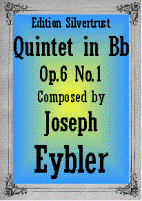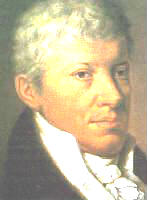Presents
Joseph Eybler
 |
 |
String Quintet in B flat Major, Op.6 No.1
For 2 Violins, Viola, Cello & Bass
or Violin, 2 Violas, Cello & Bass
“I the undersigned hereby testify that I have found the bearer, Mr. Joseph Eybler, a worthy pupil of his famous master Albrechtsberger, a thorough composer, equally skilled in chamber and church styles, very experienced in compositional technique, as well as an excellent organ and piano player—-in short a young musician such as regrettably has few peers.” So wrote Mozart in a letter of recommendation for his good friend and student, Joseph Eybler (1765-1846). And Eybler’s reputation and prominence in Vienna were such that the Empress made him Music Master to the Imperial Family in 1801 and in 1804 he was promoted to Vice-Kapellmeister, a position he held until 1824, at which time he succeeded Salieri as Imperial Kapellmeister. He held this post until his death. He was, like most of his contemporaries a prolific composer in most genres.
He wrote several string quartets and at least six string quintets. Eybler tended to view his quintets in the typical 18th century Austrian tradition as serenades. Unlike his quartets, which strictly follow the classical Viennese prescription set down by Haydn of 4 movements, the quintets usually feature at least five and sometimes more movements. Op.6 No.1 was originally published in 1801 and was for the peculiar instrumentation of Violin, 2 Violas, Cello & Bass. The standard ensemble had 2 Violins, 2 Violas and Cello. Eybler substitutes a bass for the second violin which reveals his fondness for the overall deeper sound produced by an ensemble of one soprano voice, two altos, a tenor and a bass. His concertante treatment of the parts allowed him to give both violas as well as the cello, and not just the violin, long soloistic passages. The considerable and noteworthy prominence given to the lower voices endows the music with an extraordinary depth of sound which has drawn the attention of critics in recent years and has led to the reprint of this and another quintet.
Although it is in six movements, the Quintet is
not the massive work one might expect. Eybler does not burst the borders of
chamber music and writes to scale. The charming opening theme to the Allegro
moderato, based on a turn is very Mozartean in flavor. A Menuetto
with two trios comes next. The difficult melodic material of first trio is given
over to Viola I. The second trio, a polacca, Presents
a challenge for the Cello
to the accompaniment of the violas and bass whilst the violin is tacit. In the
lovely Andantino which follows, Eybler dispenses with his concertante
style to create a finely crafted piece of integrated harmonic writing. The
listener knows he is in the realm of the serenade as the opening notes to a
second Menuetto (allegretto) are sounded. It is a canon. Again, there are
two trios. The entire first trio features the Second Viola with a beautiful
singing solo which is not at all hard to play. At last, in the second trio, the
Violin is given a chance to shine, but not without the help of the First Viola.
It is in the following Adagio that the Violin is treated as the leading
actor, the lover beneath the window sill of his beloved. Long sostenuto melodies
are woven seamlessly together leading attacca to the superb concluding
Allegretto which is a set of variations on this typical Austrian folk dance
Our edition is based on the 1801 original by Johann Traeg. Until now it has only been possible to play the quintet with Violin, 2 Violas, Cello & Bass. Nowadays, this combination almost never is assembled. Therefore, we have provided a second violin part in lieu of the second viola so that this wonderful music can now be enjoyed during an evening of quintets, say by Onslow, Dvorak and others, which are for string quartet and bass.